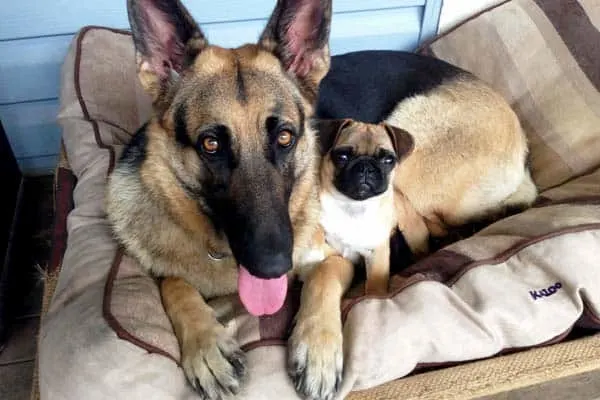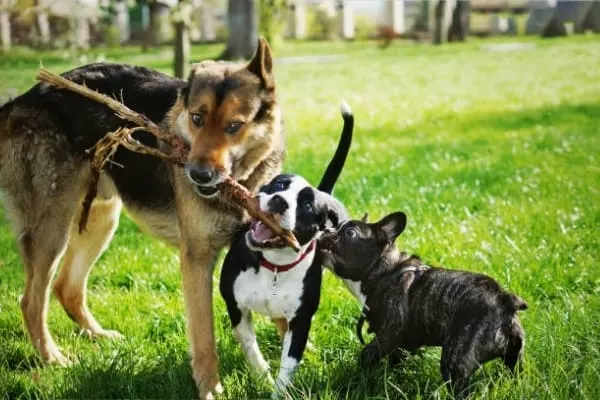Do German Shepherds Get Along With Other Dogs?
From Rin-Tin-Tin to Bullet the Wonder Dog, the German Shepherd Dog has been an icon for generations. These canines have proven themselves on the battlefield and in everyday life.
But, are these animals able to thrive in a home setting where they must get along with other dogs? Or are they meant to combat crime with their human counterparts?
In general, German Shepherds are perfectly capable of getting along with other dogs. But as with all things temperament related, this will depend on a number of factors.
There is no ‘one size fits all’ answer to this question – these are emotionally complex animals.
If you’re considering this breed, you may want to know how well they get along with other dogs. This article will explore this question in full so that you are prepared.

Are German Shepherds Friendly Around Other Dogs?
The boiled down answer to this question is that German Shepherds generally don’t have an issue when it comes to other dogs. Owners should watch out for aggressive traits, however, if not properly trained.
Don’t feel satisfied with that answer, read on for a more in-depth look.
Before we can truly label any German Shepherd as being either good or bad with other dogs, we must first understand the history. The German Shepherd as a whole has changed a lot over the years.
The Beginning of the German Shepherd
A good number of changes have been made to this breed, both in physique and personality.
Identifying these alterations can help pinpoint how a German Shepherd will act when out on a walk with other dogs nearby.
According to German Shepherd Rescue Elite, the first version of this dog originated in the 1850s in Europe.
These canines were bred solely to provide safety for the shepherds and their flocks. The goal for these dogs was to be intelligent, swift, and strong.
Thinking about the requirements of these shepherds, there was a good amount of difference. They might have similar personality traits yet differ completely in appearance.
Given the purpose, these dogs most likely were relatively polite to other dogs belonging to the shepherd though showed aggressive qualities towards any outsiders.
For quite a while, the German Shepherd shifted in morphology until the desire of a standardized breed came about.
This phenomenon started taking place for several breeds around 1891 from the Phylax Society. These members were unsuccessful though sparked the pioneers for a standardized German Shepherd Dog.
Documented by the Nova Scotia German Shepherd Dog Club as the first to create a unique vision for this breed, Captain Max von Stephanitz began this process in 1889.
His golden specimen was found at a dog show in western Germany. Hektor Linksrhein, later renamed Horand von Grafrath by von Stephanitz, was powerful, primal, agile, and intelligent.
This canine was deemed the first registered German Shepherd Dog, thus paving the way for future generations.
Unfortunately, von Stephanitz heavily inbred this dog, thus leading to several health issues.
What remained intact was a dog that had to get along with other dogs when presented alongside each other in shows.
From Shepherd to Worker
The German Shepherd Dog Club of America pinpoints another shift in these dogs around the year 1907.
Although the standardized German Shepherd was created, those in America decided to make a separate bloodline, again making drastic physical changes.
Among the most prevalent alterations made to German Shepherds in America was a slanted back. Canidae notes that this was to create an effortless trot while in the show ring.
With the start of World War I, show dogs became useless. Needed was an animal that could run without the hindrance of lowered hips.
In other words, they needed to be fit and as close to their wild ancestors as possible. Soldiers noticed the German bloodlines and how able they were in battle, bringing these dogs back with them.
The German Shepherd Dog was chosen for its elevated athleticism, intelligence, and overall devoted nature. These canines took on a new role as working dogs, continuing to serve after the war was over.
The temperament of this newly designated working dog is similar to that of the German Shepherd we see in our homes today.
It is a dog who gets along well with almost everyone, including other dogs, though can occasionally defend itself when need be.
They are incredibly loyal, even protecting their family members from potentially threatening adversaries.
The German Shepherd Dog has gone through a variety of changes over the decades. Despite these adversaries, this breed remains one of the most popular dogs in the United States.
In fact, USA Today labels them the “second most popular dog in the U.S.”, though first among those in service.
You may think it irrelevant to highlight the history of the German Shepherd, but the previous bloodlines give way to the breed we have now.
So then, is the German Shepherd Dog of today friendly with other dogs?

The Traits of the German Shepherd Dog
If you were to explore the breed’s standards under the American Kennel Club, you may find a list of personality traits such as being fearless, non-hostile, self-confident, eager to please, and alert.
Words that do not describe the typical German Shepherd Dog include “timid” and “shy”. The breed itself is known to be approachable. But, does this apply to humans or other animals?
For the most part, German Shepherds tend to get along with most dogs if they have been properly socialized from a young age.
There are cases where these canines can become aggressive towards other dogs of the same sex.
As with any dog, it is important to consider that yours might not exactly match the breed standard. Each individual is unique in temperament.
The experiences that a German Shepherd goes through from a young age fosters a certain repertoire for future interactions.
It is also important to keep in mind that the German Shepherd dog is highly bonded to their owners, making it all the more likely that they will become protective and aggressive without the proper training.
This is a common problem amongst German Shepherd owners since they have a phenomenal guard dog without the proper honing.

Why Might a German Shepherd Be Aggressive?
Those wondering why they see aggressive traits in their German Shepherd should realize that this breed is incredibly honest. What we mean by this is that they won’t act out without a proper reason.
A German Shepherd Dog who lashes out at other dogs may be dealing with a number of the following problems:
Protectiveness: By nature, the German Shepherd is irrevocably devoted to its owner. Without proper assurance and training, these dogs can see other dogs as potential threats to their humans.
Lack of Exercise: Without a minimum of two hours of physical exertion, this breed can lash out.
Poor Handling: These dogs are eager to please, yet respond poorly when dominated due to their self-confident nature.
Take the time to thoroughly train your German Shepherd in a way that works for both you and the dog.
Boredom: The German Shepherd does not do well when left at home alone for long periods. This is largely due to their strong bonds and high energy.
Aggression can manifest when left with nothing to do for too long.
Above all else, it is important to remember that this breed is a working dog at heart. They may enjoy being a couch potato from time to time, but this does not fit their everyday needs.
If not given the proper amount of exercise and leadership, these dogs can show signs of aggression towards other dogs.
How to Make Sure That Your German Shepherd Plays Nice
If you’re nervous about potential aggression spiking up in your German Shepherd, there are some solutions that can negate this behavior altogether.
This will be much easier if you’re working from scratch. Those with a German Shepherd puppy should provide the following:
Socialization: This honestly is among the most important steps in raising a proper canine citizen. Take the time to let them meet other friendly dogs from an early age.
Puppy Classes: These seminars not only offer a controlled environment for socialization but provide a basis for doggy etiquette.
Showing your little one how to behave respectfully and in a manner that is deemed acceptable will pave the way for a friendlier adult dog.
For a visual example, we have provided a video on how to socialize your puppy to other dogs from a professional dog trainer, Zak George.
Oftentimes dogs are not given these tools and become overprotective and aggressive.
Although more difficult to recondition, adult German Shepherds can be taught to like other dogs despite their bad experiences.
The solution to an aggressive German Shepherd adult involves lots of training and positive reinforcement.
They need to learn that other dogs mean something good instead of a potential competitor. We advise that you seek the guidance of a professional trainer if dealing with an aggressive adult German Shepherd.
Taking the time to properly socialize, train, and exercise your German Shepherd will make walks more enjoyable for both you and your dog.
Remember that these dogs have been conditioned to be incredibly attentive. With the right aids, your German Shepherd Dog will be friendly towards other dogs.






























